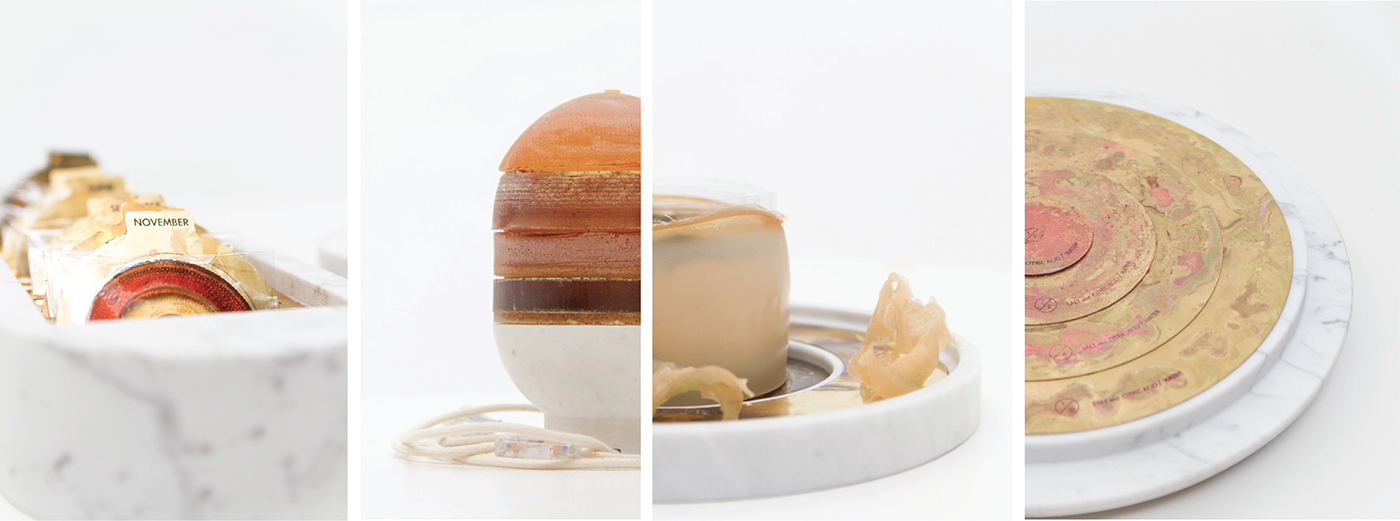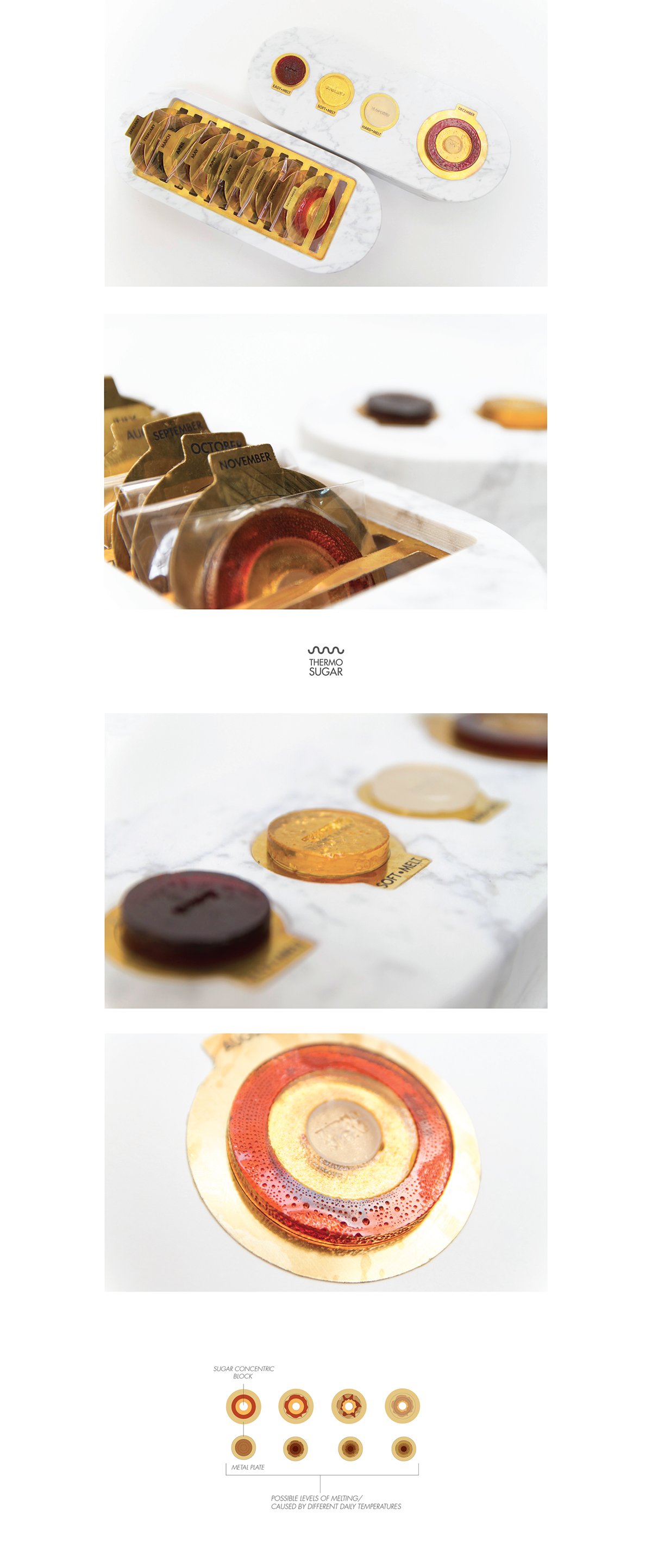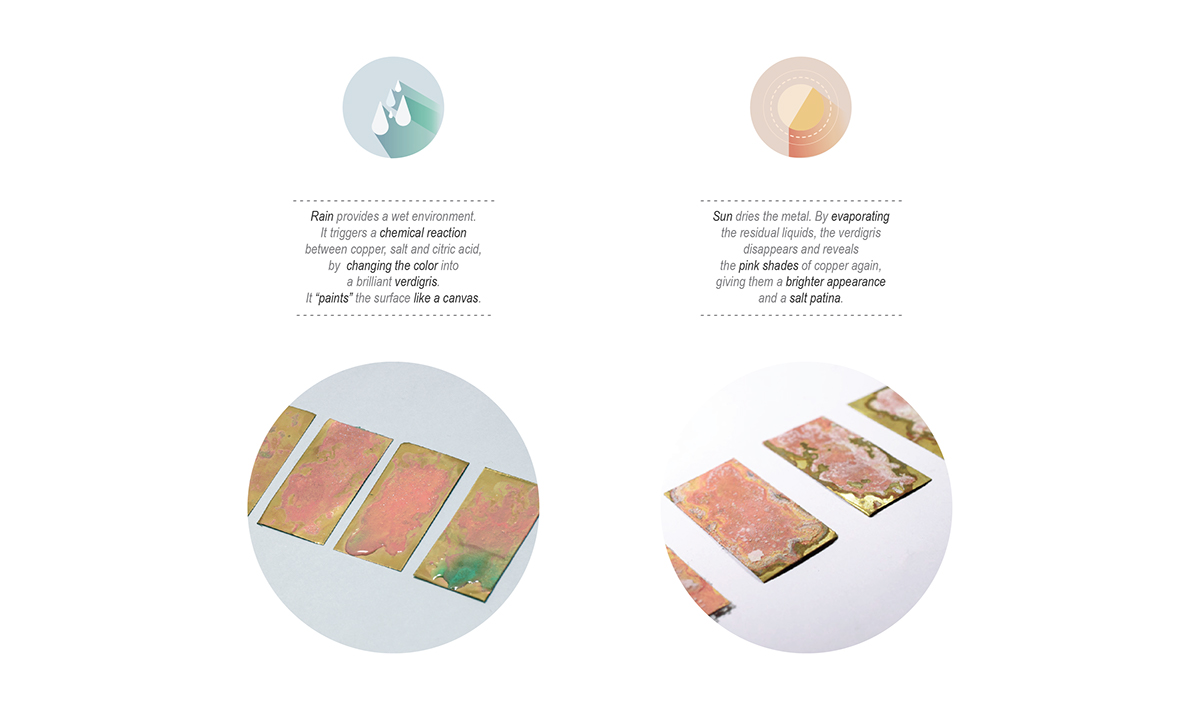
" ... Matter hides a sensititvity
and a secret inner life
that lies beneath the surface.
It acts, re-acts and change
in front of certain stimuli ... "
and a secret inner life
that lies beneath the surface.
It acts, re-acts and change
in front of certain stimuli ... "
- - - - - - - - - - - - - - - - - - - - - - - - - - - - - - - - - - - - - - - - - - - - - - -
I've always been fascinated by the idea that the reality
that surrounds us conceals something mysterious and intriguing:
an entire universe made of constant changes,
mutations and transformations of matter.
In some cases they are invisible and silent processes
and for this reason, they remain unnoticed, for most of the times.
But I wanted to bring to light these processes, and establish
“new dialogues” with materials that we can use every day.
My objective, in fact, is to demonstrate that matter
is not something static or motionless but “it’s alive”...
And that it's possible to take advantage
of material's peculiar behaviors.
- - - - - - - - - - - - - - - - - - - - - - - - - - - - - - - - - - - - - - - -

- - - - - - - - - - - - - - - - - - - - - - - - - -
"The behavior of materials"
is a collection of 4
unconventional objects:
a melting-sugar thermometer,
a light-refracting resin lamp, bowls
made of layered bioplastic skins and a
brass outdoor sculpture
"painted" by the rain.
Each object explore
one singular material,
and by using it we participate
in its life process,
discovering and adapting
to its behaviour : Our interaction exists
as long as these objects are "alive",
and their materials are still "re-active".
- - - - - - - - - - - - - - - - - - - - - - - - - - -

- - - - - - - - - - - - - - - - - - - - - - - - - -
The material / ISOMALT SUGAR
- - - - - - - - - - - - - - - - - - - - - - - - - -
To know better this material
I started doing experiments
by changing the melting tempeartures:
|| ISOMALT TEMPERATURE + 200°C ||
burnt, excessive temperature
alters the color visibly (dark red)
sticky and unstable.
Dissolve easily at warm temperatures.
|| ISOMALT TEMPERATURE 170°C ||
medium stability, softens,
slowly melts at very high temperatures.
|| ISOMALT TEMPERATURE 140°C||
stable,it can last more than a year.

- - - - - - - - - - - - - - - - - - - - - - - - - - - - - - - - - - - - - - - - - - - - - - - - - - - - - - - - - - - - - - - -
BUT HOW CAN WE TAKE ADVANTAGE OF
ITS MELTING PROPRERTIES ?
- - - - - - - - - - - - - - - - - - - - - - - - - - - - - - - - - - - - - - - - - - - - - - - - - - - - - - - - - - - - - - - -
"THERMO-SUGAR" Is a melting-sugar thermomether that lasts for one year.
A marble box stores 12 circular isomalt blocks, one per month.
This stone, in fact, has good thermic properties
and keep the sugar intact and fresh.
Each concentric circle follows
the 3 melting temperatures (RED-YELLOW-WHITE)
from the most sensitive to the more resistant to heat. Each month we take out
a sugar block and we place it on the top of the lid, above its correspondent metal plate.
In this way we'll observe how much its shape changes and transforms every day
because of the temperature of the environment. At the end
we can collect this small sculpture of melted sugar which represents a sort
of “thermal footprint” of the environment were we live.


- - - - - - - - - - - - - - - - -
Tests and experiments
- - - - - - - - - - - - - - - - -

- - - - - - - - - - - - - - - - - - - - - - - - - -
The material / BRASS
- - - - - - - - - - - - - - - - - - - - - - - - - -
The material / BRASS
- - - - - - - - - - - - - - - - - - - - - - - - - -
Rain Canvas is a brass surface,
designed to be placed outdoors.
designed to be placed outdoors.
A plate with a slight rocking motion
caused by the interaction
caused by the interaction
with weather natural elements.
It explores the process
of "DENZICIFICATION".
Brass is an alloy
made of Zinc and Copper
and by treating it with acid elements,
is possible to reveal its inner personality:
it loses the zinc and shows the copper below.
I used different ratio of a specific solution:
(water / salt + acid)
10:1 4:1 2:1 1:1
to experiment different levels of oxidation intensity.
The result is a series of brilliant pink shades,
which are going to change acording to
Rain and Sun.


The object is a sort of " Mapping-tool"
able to detect informations about the natural environment.

- - - - - - - - - - - - - - - - - - - - - - - - - -
The material / BIOPLASTIC
- - - - - - - - - - - - - - - - - - - - - - - - - -

Different bio-plastic recipes.
Bio-plastic is an incredible organic material.
This investigation followed a basic recipe consisting of:
1 POLYMER + 1 PLASTICIZER + ADDITIVES
1 POLYMER + 1 PLASTICIZER + ADDITIVES
It was interesting to observe that by changing the polymer, it's possible
to obtain new material properties: softer,harder,porous texture, elastic, durable, fragile etc.
I used, as polymer, Corn Starch, Agar Agar or Animal Gelatine.

- - - - - - - - - - - - - - - - - - - - - - - - - - - - - - - - - - - - - - - - - - - - - - - - - - - - - - - - - - - - - -
"Fading skin-bowl" is a series of bowls and vases made of bio-plastic layered skins.
Each layer is made with a different recipe: from the more
fragile (the external one), to the more resistant (the innermost).
This material is subjected to the constant passage of time:
the object slowly breaks in pieces and decomposes.
By peeling and unwrapping the several levels/skins, the bowl size changes.
- - - - - - - - - - - - - - - - - - - - - - - - - - - - - - - - - - - - - - - - - - - - - - - - - - - - - - - - - - - - - -

- - - - - - - - - - - - - - - - - - - - - - - - - - - -
Each object of this collection
has a metal plate.
Its function is to "record" life,
movements and changes
of the materials analyzed,
by giving us a visual
and graphic representation of
their "life stages" .
- - - - - - - - - - - - - - - - - - - - - - - - - - -


- - - - - - - - - - - - - - - - - - - - - - - - - -
The material / DAMMAR RESIN
- - - - - - - - - - - - - - - - - - - - - - - - - -
This natural resin comes from the Asian
Dipterocarpaceae plants family.
What catched my interest is the term
Dammar : it means “torch”.
In fact, this resin presents interesting
light reflaction qualities.
In fact, this resin presents interesting
light reflaction qualities.

Refract Lamp is a modular structure.
The material, has been melted and resolidified from 1 to 10 times,
with status transitions of matter (solid-liquid-solid), and using temperatures
that modify and re-distribute, from time to time, the internal
that modify and re-distribute, from time to time, the internal
composition of atoms and of the crystals that compose the resin.
This change the resin aspect (a colour scale from yellow to brownish-red)
Each of them creates different light refractions modes,
in accordance with the different resin color temperatures,
in accordance with the different resin color temperatures,
that reveals the multiple “inner personalities”
of light and of this material.


I created a set of 4 resin pieces, one for each color/temperature
and numbers of material's status transitions.
The atmosphere of the environment
will be the result of our interaction
with the lamp:
will be the result of our interaction
with the lamp:
" we can decide how many cilinders
to use and the correspent addittive light colour."


- The Refract lamp -

Installation for the exhibition "Why not Design?"
of the "Master of Design and Innovation" at IED MADRID.



